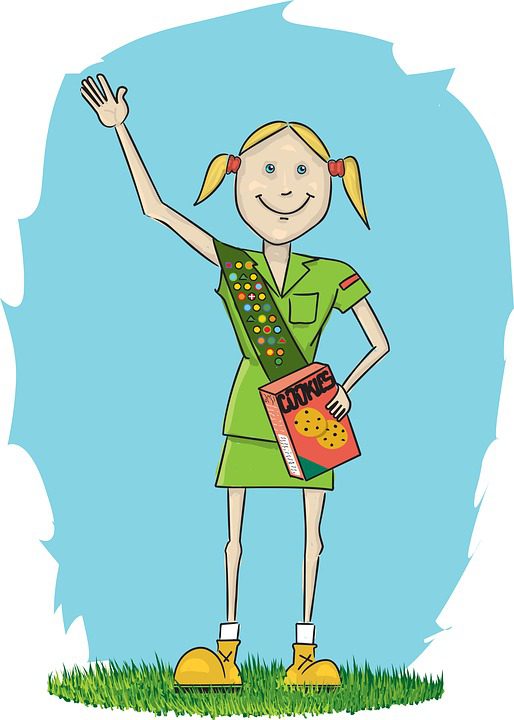Defense Against Catcalling, for Girl Scouts

One out of ten girls is catcalled before she turns eleven years old. Eleven years old. That’s fourth grade. Guys, I know some of you are thinking, “What’s wrong with telling a girl she is pretty?” What’s wrong is that the message in society is that pretty is the most important thing. Boys and men, you might not get this intuitively. Guys, you want to be attractive, too. I get that. But you are not told that is the be-all and end-all of your adult successes.
What’s the big deal? According to Developmental Psychologist, Dr. Andrea Bastiani Archibald,
“Catcalling and other objectifying behaviors can make girls feel their value lies solely in how they look as opposed to what they think or the things they can accomplish. That kicks off a domino effect of girls engaging in self-objectifying—feeling overly concerned about how they look, comparing their bodies to those of other girls and women, and even judging other girls based on their looks.”
 The Girl Scouts of America know this is a problem for their girls. To succeed in today’s world, Girl Scouts need to know more that making campfires and selling cookies.
The Girl Scouts of America know this is a problem for their girls. To succeed in today’s world, Girl Scouts need to know more that making campfires and selling cookies.
Here’s what GSA advises:
- Point out pop-culture sexism
One of the easiest ways to broach the topic of catcalling and sexual harassment is to point it out on TV shows, in movies, and in real life. When you witness catcalling or other sexual intimidation (and sadly, you won’t have to look hard to find it), raise the interaction to your daughter and tell her why it was inappropriate and unacceptable. Since sexist remarks and catcalls are often used as a punch-line in pop-culture, make sure to talk about why these behaviors aren’t funny at all. Ask your daughter how she feels about the exchange in question, and whether anything like that has ever happened to her. - Get talking
Catcalling and sexual harassment may seem like very grown-up topics, but many girls are targeted in this way while they’re still in elementary school—and only two percent of girls ever tell their parents when it’s happened to them. That’s why it’s important to start the conversation early—think, third or fourth grade—to let your daughter know it’s a topic she should feel comfortable bringing to you. - Let her know it’s never, ever her “fault”
When you talk about catcalling and other gender-based harassment, emphasize that no girl or woman is ever “asking for” or “doing anything to deserve” an objectifying comment or threats. Girls and women should feel free—just as boys and men do!—to go where they want, when they want, wearing what makes them comfortable, without fear of intimidation or abuse. Sadly, many girls and women of all ages blame themselves when they’re harassed, so make sure she knows that unwanted attention in the form of prolonged stares, lewd comments, or touching of any kind without her express consent is never, ever her fault—and not something she should feel ashamed telling you or another adult about. - Arm her with what to say and do
Knowing how to react to catcalling can be confusing—especially to girls who have been raised to always be polite, especially to adults, and who are surrounded by a society that emphasizes the importance of being pretty and attractive to the opposite sex.
Emphasize that since catcalling itself is the opposite of polite, there’s no need to smile, laugh, or engage in conversation with the harasser. In fact, make sure she knows that smiling, laughing, or chatting with someone who makes lewd comments can unintentionally encourage more of the same kind of behavior and even put her in danger. Help your daughter to follow this rule of thumb: If an adult is making her feel uncomfortable or acting inappropriately, she should get away from that person as soon as possible and immediately tell you or another caring adult about what happened.
Meanwhile, if another kid at school or in an extra-curricular activity is making her feel uncomfortable with catcalls or other forms of sexual harassment, she can either walk away and tell an adult, or, if she feels safe enough to do so, explain to the other child that such actions aren’t okay, and that they need to stop. Still, if that behavior continues, your daughter will need to tell a trusted adult—not just to help herself out of a tough situation, but because the harasser could be doing the same or worse to other girls who might not have the strength to speak out about it.

I would add some specifics here:
I teach a bystander class designed for teenagers. Young people benefit from more sample statements to help deflect bias speech of all kinds (whether it is sexist speech, or bias speech against ethnic, religious, or racial differences.) I would advise parents to empower their children by teaching them basic ways to stand up against biased speech. In the case of catcalling:
Tactic: Assertive ignoring.
Teach your children to keep walking when they are being catcalled on the street. In open space, it is best to keep your distance from disagreeable people. Posture matters. Show your children how to look strong and assertive when walking in public places. Head upright, eyes forward, gait steady and not running.
If your child must address the catcaller:
Tactic: Naming the behavior. Describe the behavior in non-judgmental language. In the case of catcalling, I think a question, in a neutral tone would work:
“Did you just whistle at me?”
“Did you just call me ‘sweetheart’?
Tactic: I messages. Stating a personal reaction to the comment.
“I do not like being whistled at.”
“I am not your sweetheart.”
“I don’t like being spoken to like that.”
If someone catcalls, and then follows your child:
Tactic: Look up
If someone catcalls your child and then follows her, teach your child to make noise and get attention. She should walk towards other people. She should shout or bang a wall to draw attention to the situation. Most people are good and kind. They will help a little girl who is being catcalled. Some of the things she can say:
“Please go away! Go away!”
“I don’t know these boys (men). They are bothering me!”
“Look up! I need help”
“Someone help me! These boys (men) are following me.”
Back to what the Girls Scouts advise:
- Talk to boys and young men in your life
If you have sons or other young men in your life, have conversations about catcalling and sexual harassment with them, too. Using pop-culture or events in real life or on the news is always a solid way to introduce the topic. Let them know these kinds of behaviors are never OK, and why they’re damaging to people of both genders. Then, ask him why he thinks other boys and men behave this way. Discuss ways that he can help fight back against the catcalling culture—whether it’s standing in solidarity with girls and women when he sees them being targeted in real life, refusing to laugh at sexist jokes, or calling out his friends if he sees them engaging in sexist behavior. We all have to stand together if we want to create a better, safer, and healthier world. - Take action
If you think this is a big problem in your community—as it is in many communities, sadly—you might want to consider getting more involved. Talk to your daughter’s teachers and other school administrators about planning an assembly or other student (or parent-student) event to address the pressures put on both genders to fit certain stereotypes, and why and how those stereotypes can lead to damaging behaviors like catcalling and other kinds of gender-based harassment.
If you are interested in my Bystander Intervention classes, please join my mailing list to hear about upcoming classes. Check out the upcoming classes.